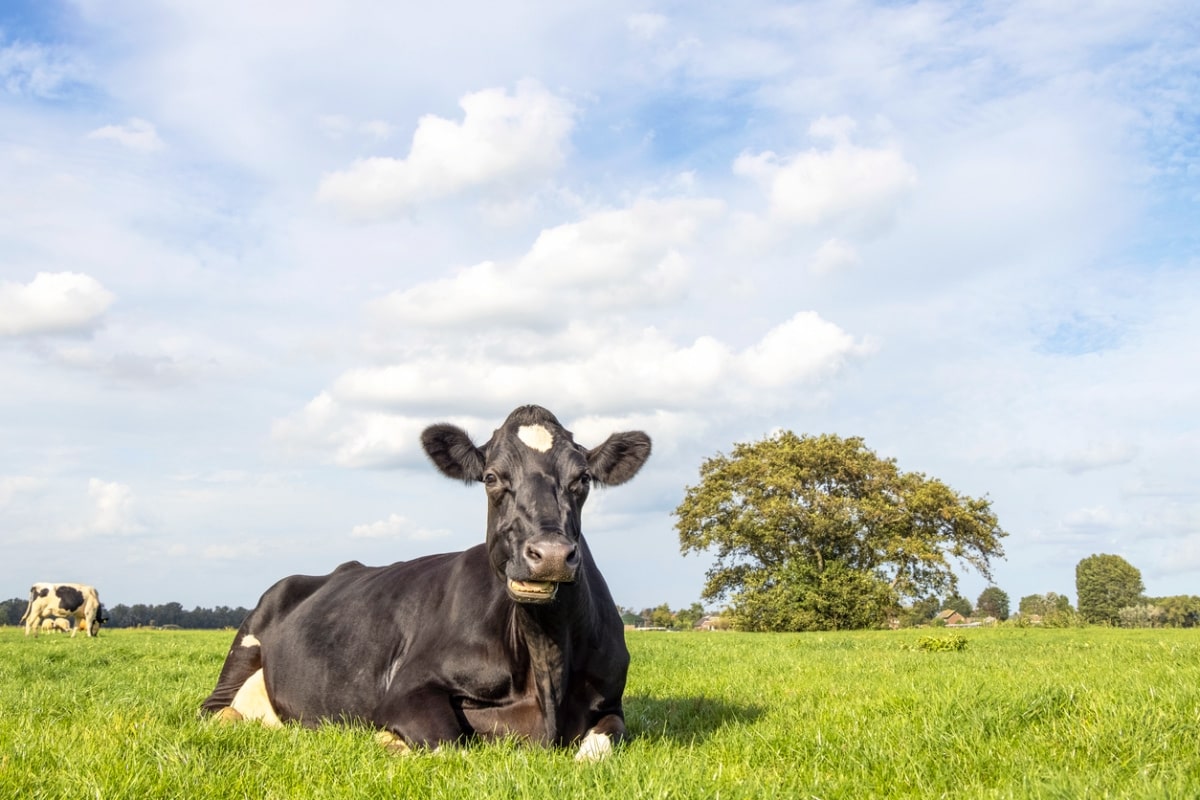Dairy cows typically spend about eight hours a day chewing cud, totaling 30,000 chews daily. Cud chewing is a fundamental part of cow digestion. It stimulates saliva production, which contains natural antacids that help buffer the rumen. Therefore, anything preventing or discouraging your cows from ruminating (cud chewing) will affect their productivity and health.
Why Do Cows Chew Cud?
Cows chew cud because they are ruminants, like sheep, goats, deer, and even giraffes. Ruminant digestive systems rely on cud chewing to fully process and extract nutrients from fibrous plant materials.
After ingestion, plant matter enters the rumen, where beneficial bacteria begin breaking it down and fermentation starts.. After some time, the cow regurgitates a portion of this partially digested material (known as cud) for additional chewing. This second round of chewing further breaks down fiber and mixes it with saliva to aid digestion. Once re-chewed, the cud is swallowed and continues through the digestive system for nutrient absorption.
How Cud Chewing Affects Milk Production
Cow cud chewing plays a critical role in digestion, directly impacting milk yield and overall health. As cows chew cud, they produce saliva, which helps maintain proper rumen pH — ideally between 6.2 and 6.8.
Saliva is rich in bicarbonate, a natural buffer that counteracts the acidity generated by microbial activity and certain feeds. When cud chewing decreases, so does saliva production. As a result, rumen pH can drop, increasing the risk of sub-acute rumen acidosis (SARA).
SARA negatively affects feed intake, reduces milk production, and can lead to broader health problems, including lethargy and diarrhea. Maintaining consistent rumination is essential for preventing these issues and supporting optimal performance in the herd.
Is Your Cow Not Chewing Cud? Watch for These Effects
If a cow isn’t chewing cud, it may be a sign of underlying health or nutritional issues. Monitor for the following symptoms, which are commonly associated with reduced rumination:
- Lameness
- Digestion issues
- Lethargy
- Lowered milk fat
- Reduced milk yield
- Displaced abomasum
While the absence of cud chewing is not always the root cause, it often contributes to rumen acidosis, which can lead to health and productivity challenges. Observing rumination behavior can help identify problems early and guide nutritional adjustments.
How to Improve Cud Chewing
A well-balanced feed program is essential for stimulating cud chewing, which in turn supports saliva production and stable rumen pH. According to the University of Kentucky, 15–20% of the forage in a ration should measure 1.5 to 2 inches to effectively promote rumination.
Effective forage fiber stimulates the nerves in the rumen wall, initiating regurgitation and re-chewing. Coarser forage (rather than pulverized or overly processed material) makes it easier for cows to regurgitate and chew, improving digestion.
Star Blends works with your nutritionist to formulate custom beef and dairy cow feed for your particular herd needs. These include an optimized balance of forage fiber, protein, carbohydrates, fat, and micronutrients. Balanced animal nutrition will help maximize your herd’s cud chewing, digestion, productivity, and your bottom line.
Cud chewing is influenced by both feed structure and management practices. To support it:
- Use high-quality feeds with a balanced mix of fiber, carbohydrates, protein, and energy. Excessive starch can depress rumen pH, even in cows chewing cud.
- Test forage to know exactly what your herd consumes.
- Avoid over-mixing. Running the TMR mixer longer than 3–5 minutes can reduce forage particle size, limiting its effectiveness in stimulating cud chewing.
- Don’t separate long-fiber from the feed. Cows may not consume enough correct feed for proper rumination. Or they may consume them later in the day, when SARA has already affected their rumen.
- Ensure consistent feeding times to support regular eating behavior and strengthen habitual rumination patterns.
- Provide evenly mixed rations to ensure uniform fiber intake.
- Offer adequate access to bedding and shade, especially during hot weather, to reduce heat stress, which can suppress rumination.
- Observe your herd regularly. About 60–70% of cows at rest should be chewing cud. If fewer are ruminating, talk to your nutritionist about adjusting the ration mix.
- Watch for inconsistent chewing rates. According to Hoard’s Dairyman, cows should perform 50–70 chews per cud, though this may vary. Share any notable patterns with your nutritionist.
Better Feed, Better Cud: Optimize Rumination With Star Blends
Healthy rumination means healthier cows, better milk production, and fewer metabolic issues. If cud chewing is off, your ration could be, too. Improving feed formulation with the right nutritional profile for your herd can boost digestion and, in turn, milk yield.
Star Blends custom feed manufacturing is here to deliver rations that move the needle and support optimal rumen activity. Contact us today to learn how we can help keep your herd chewing, producing, and thriving.



